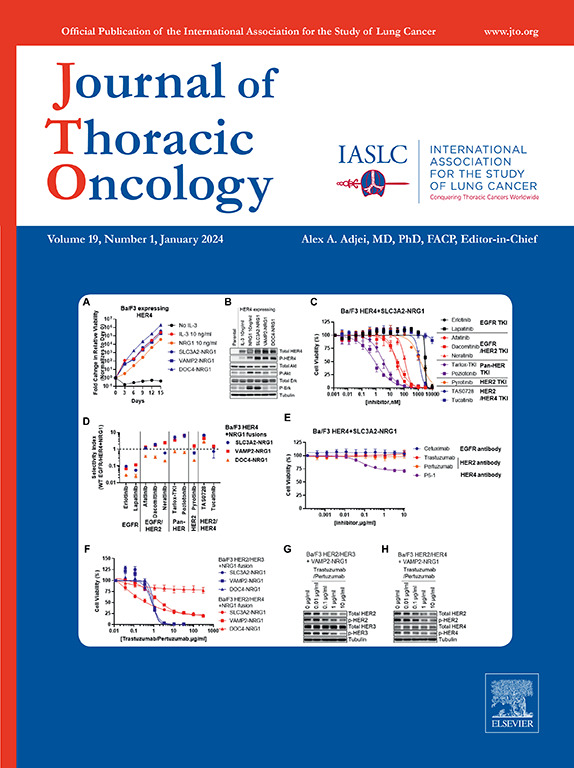接受化学免疫治疗的晚期非小细胞肺癌的肠道微生物群:来自III期试验的辅助生物标志物研究。
IF 20.8
1区 医学
Q1 ONCOLOGY
引用次数: 0
摘要
背景:免疫疗法已经改变了非小细胞肺癌(NSCLC)的治疗方法。然而,用于治疗选择的可靠生物标志物仍然很少。肠道微生物群已成为一种潜在的生物标志物,但其在非小细胞肺癌的化学免疫治疗中的作用尚不清楚。方法:III期试验(JCOG2007, NIPPON)比较了派姆单抗加铂双重化疗(PC)和尼武单抗加铂双重化疗(NIC)在treatment-naïve无驱动基因改变的晚期NSCLC患者中的疗效。作为一项辅助生物标志物研究,研究人员分析了295名患者中270名基线粪便样本的肠道微生物群组成。采用16S rDNA测序进行多样性和差异丰度分析。结果:总体队列(n=270)的β多样性分析揭示了总生存期(OS)是否超过12个月或18个月的亚群之间不同的微生物结构。随后的LEfSe分析确定了不同亚群之间的特定细菌属,Fusicatenibacter, Butyricicoccus和Blautia在较长OS患者中富集。关于不良事件(ae),较低的微生物α多样性和某些分类群的存在与严重(≥4级)ae的高风险相关。此外,包括Fusicatenibacter和Butyricicoccus在内的有利属与较低的严重ae风险相关。最后,方案特异性分析显示,与CP组相比,NIC组中Fusicatenibacter和Butyricicoccus丰度较高与更好的OS相关(OS的风险比(HR)分别为0.56和0.52)。相反,Prevotellaceae NK3B31丰度越高,NIC组的死亡风险越高(OS的HR = 2.33)。结论:肠道微生物群可作为晚期非小细胞肺癌化疗免疫治疗的生物标志物。微生物多样性和特定细菌属的差异与预后和严重不良反应有关,并具有潜在的方案特异性影响。这些发现支持将肠道菌群分析纳入临床实践,以优化一线治疗策略。本文章由计算机程序翻译,如有差异,请以英文原文为准。

Gut Microbiota in Advanced NSCLC Receiving Chemoimmunotherapy: An Ancillary Biomarker Study From the Phase III Trial JCOG2007 (NIPPON)
Introduction
Immunotherapy has transformed the treatment for NSCLC. Nevertheless, reliable biomarkers for treatment selection remain scarce. Gut microbiota has emerged as a potential biomarker, but its role in chemoimmunotherapy for NSCLC is unclear.
Methods
The phase III trial (JCOG2007, NIPPON) compared pembrolizumab plus platinum doublet chemotherapy (PC) with nivolumab and ipilimumab plus platinum doublet chemotherapy (NIC) in treatment-naive patients with advanced NSCLC without driver gene alterations. As an ancillary biomarker study, 270 patients with baseline fecal samples were analyzed for gut microbiota composition from 295 patients enrolled. 16S ribosomal DNA sequencing was performed for the diversity and differential abundance analysis.
Results
The beta diversity analysis of the overall cohort (n = 270) revealed distinct microbial structures between the subpopulations defined by whether overall survival (OS) exceeds 12 or 18 months. Subsequent linear discriminant analysis effect size analysis identified specific bacterial genera that differed between the subpopulations, with Fusicatenibacter, Butyricicoccus, and Blautia being enriched in patients with longer OS. Regarding adverse events (AEs), lower microbial alpha diversity and the presence of certain taxa were linked to a higher risk of serious (≥grade 4) AEs. In addition, favorable genera, including Fusicatenibacter and Butyricicoccus, were associated with a lower risk of serious AEs. Last, regimen-specific analysis demonstrated that higher abundance of Fusicatenibacter and Butyricicoccus was linked to better OS in the NIC arm compared with that in the CP arm (hazard ratio for OS = 0.56 and 0.52, respectively). Conversely, the higher abundance of Prevotellaceae NK3B31 was associated with higher mortality risk in the NIC arm (hazard ratio for OS = 2.33).
Conclusions
Gut microbiota may serve as a biomarker for chemoimmunotherapy in advanced NSCLC. Differences in microbial diversity and specific bacterial genera were associated with prognosis and serious AEs, with potential regimen-specific effects. These findings support integrating gut microbiota profiling into clinical practice to optimize first-line treatment strategies.
求助全文
通过发布文献求助,成功后即可免费获取论文全文。
去求助
来源期刊

Journal of Thoracic Oncology
医学-呼吸系统
CiteScore
36.00
自引率
3.90%
发文量
1406
审稿时长
13 days
期刊介绍:
Journal of Thoracic Oncology (JTO), the official journal of the International Association for the Study of Lung Cancer,is the primary educational and informational publication for topics relevant to the prevention, detection, diagnosis, and treatment of all thoracic malignancies.The readship includes epidemiologists, medical oncologists, radiation oncologists, thoracic surgeons, pulmonologists, radiologists, pathologists, nuclear medicine physicians, and research scientists with a special interest in thoracic oncology.
 求助内容:
求助内容: 应助结果提醒方式:
应助结果提醒方式:


